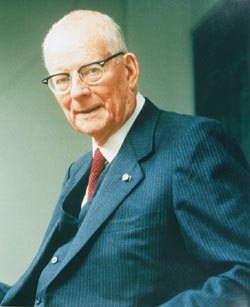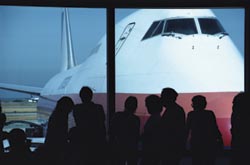 New
Deming Cup Recognizes Strategic Company Growth New
Deming Cup Recognizes Strategic Company Growth
The Deming Center, an organization
located within the Columbia University Graduate School of
Business, has announced the creation of the Deming Cup,
an award designed to recognize companies for operational
excellence and creating shareholder value through strategic
growth. The prize, as well as the center, are named for
the late quality pioneer W. Edwards Deming.
In order to be considered for the Deming Cup, companies
must demonstrate a plan for top-line growth, with significant
accomplishments in expansion, including margins, market
share, revenue and future potential. Results must be guided
by the interests of all stakeholders, and performance improvement
and assessment data must be readily available.
Companies that apply for the Deming Cup are evaluated
using the following criteria:
 Does the company show exceptional growth in a challenging
market?
Does the company show exceptional growth in a challenging
market?
 How well do the company's senior executives set strategic
directions and build and maintain a leadership system conducive
to superior top-line performance through organizational
learning?
How well do the company's senior executives set strategic
directions and build and maintain a leadership system conducive
to superior top-line performance through organizational
learning?
 Is the company's information culture closely aligned with
its strategic directions?
Is the company's information culture closely aligned with
its strategic directions?
 Does the applicant truly understand the needs of customers
and the marketplace through real-time access to results
and trends analysis?
Does the applicant truly understand the needs of customers
and the marketplace through real-time access to results
and trends analysis?
Companies, or a division of a company, with less than
$500 million in annual sales are eligible. Companies can
nominate themselves for the prize, or a third party can
nominate. The nominated company must have a plan that defines
specific and measurable outcomes and must agree to serve
as a model that can be replicated or adapted by other organizations.
Learn more about the new Deming Cup at www.demingcenter.com.
L.S. Starrett Denies Allegations of Fraud
According to an article in
the Sept. 12 issue of the Wall Street Journal, the Justice
Department is examining whether the L.S. Starrett Co. defrauded
its customers by selling them substandard equipment.
Starrett denies all allegations and says it is fully cooperating
with the investigation.
The investigation stems from a civil lawsuit filed by
a subcontractor employed by Starrett. The suit alleges that
the company was aware of accuracy problems with its Rapid
Check line of CMMs but failed to take appropriate action
to inform its customers. 
"The company, on its own initiative, and as part
of its review of its Rapid Check product line, made certain
improvements to the machines and incorporated these improvements
in new machines," Starrett's official response states.
"The company informed its customers of these improvements,
and in March 2002, began a program to replace all of its
Rapid Check machines at no cost to customers. This replacement
program has continued to the present date."
The statement goes on to announce, "[Starrett] is
confident that after all the facts are reviewed, it will
be determined that the company acted in a lawful and responsible
manner."
The investigation is being conducted by the U.S. attorney's
office in Boston, with assistance from NASA representatives,
U.S. postal inspectors, agents from the Federal Bureau of
Investigation and the Defense Criminal Investigative Service,
according to the article.
Workers Rate Commute as the Best Part
of Their Jobs
 A
recent survey concludes that American workers are less satisfied
with their jobs than they once were. Overall discontent
was reported for all age groups, income brackets and areas
in the United States. Only about half of the Americans recently
surveyed about job satisfaction said they're happy with
their employment situation; this represents about a 10-percent
decline in job satisfaction since the last survey in 1995. A
recent survey concludes that American workers are less satisfied
with their jobs than they once were. Overall discontent
was reported for all age groups, income brackets and areas
in the United States. Only about half of the Americans recently
surveyed about job satisfaction said they're happy with
their employment situation; this represents about a 10-percent
decline in job satisfaction since the last survey in 1995.
"The widespread feeling among many Americans that
their jobs aren't providing the satisfaction they once did
is likely to be a growing concern for management,"
says Lynn Franco, director of The Conference Board's Consumer
Research Center.
The study shows that workers are least satisfied with
bonus plans, promotion policies and educational training
programs. The percentage of Americans who say they enjoy
working with their colleagues declined as well, from 64
percent in 1995 to 59 percent. "About the only thing
workers seem exceptionally pleased about is their commute
to work," adds Franco. Survey respondents rated their
commute to work as the best part of their job, with a 58.7
percent satisfaction rate.
Workers 35 to 44 years old are least content, according
to the survey. Less than 48 percent are satisfied, down
from nearly 61 percent in 1995. About 48 percent of older
workers, from 55 to 64, say they're satisfied.
The survey also shows that job satisfaction is dependent
on income. Workers earning more than $50,000 a year are
more satisfied than households earning less than $15,000
a year--the least satisfied of all income groups.
Other key findings include:
 The largest decline in overall job satisfaction--from 60.9
percent in 1995 to 47.4 percent this year--occurred among
workers between 35 to 44. People in this age bracket were
once the most satisfied group.
The largest decline in overall job satisfaction--from 60.9
percent in 1995 to 47.4 percent this year--occurred among
workers between 35 to 44. People in this age bracket were
once the most satisfied group.
 Although the overall level of satisfaction among households
earning more than $50,000 declined from 66.5 percent to
55.2 percent, this group represents the most-satisfied workers.
Although the overall level of satisfaction among households
earning more than $50,000 declined from 66.5 percent to
55.2 percent, this group represents the most-satisfied workers.
 The New England region experienced the most significant
decline in satisfaction, from 65.4 percent to 44 percent.
The New England region experienced the most significant
decline in satisfaction, from 65.4 percent to 44 percent.
 Although there was a decline from 62.7 percent in 1995,
workers in the Rocky Mountain region are most satisfied,
at 57 percent.
Although there was a decline from 62.7 percent in 1995,
workers in the Rocky Mountain region are most satisfied,
at 57 percent.
The survey, conduced for The Conference Board by NFO WorldGroup,
is based on a representative sample of 5,000 Americans of
all ages and income brackets. Learn more at www.consumerresearchcenter.org.
 ASQ
Proposes Airport Security Screening Certification ASQ
Proposes Airport Security Screening Certification
Since January, the American
Society for Quality has been working with the U.S. Department
of Transportation's Transportation Security Administration
in an effort to restore the public's confidence in air travel.
With the intention of providing a renewed trust in airport
security, ASQ has offered the TSA a proposal to develop
and administer a certification program for airport security
screening personnel. Originally requested by the Federal
Aviation Administration in the wake of the Sept. 11 attacks,
the proposal is a result of correspondence between ASQ and
the FAA on ways in which quality improvement processes might
be implemented as government agencies take over the responsibility
of security at airports across the United States.
As outlined in the proposal, ASQ is interested in taking
the following responsibilities:
 Giving the TSA access to its certification process and assisting
in the implementation of that process
Giving the TSA access to its certification process and assisting
in the implementation of that process
 Retaining copyright of the certification to protect the
security of the examination and administering it according
to a schedule determined by the TSA. ASQ will partner with
the TSA in determining the cost of the examination to each
candidate.
Retaining copyright of the certification to protect the
security of the examination and administering it according
to a schedule determined by the TSA. ASQ will partner with
the TSA in determining the cost of the examination to each
candidate.
 Conducting all logistical elements necessary to administer
successful examinations, including registration, fee collection,
establishment of test sites, arranging for proctors, scoring
exams and reporting results. ASQ will also provide the TSA
with analytical reports on each exam.
Conducting all logistical elements necessary to administer
successful examinations, including registration, fee collection,
establishment of test sites, arranging for proctors, scoring
exams and reporting results. ASQ will also provide the TSA
with analytical reports on each exam.
 Conducting the certification under guidelines established
by the TSA and other relevant agencies identified by the
TSA
Conducting the certification under guidelines established
by the TSA and other relevant agencies identified by the
TSA
 Providing all assistance pro bono
Providing all assistance pro bono
The proposal states that the those passing the exam would
be certified by TSA, not ASQ. Successful candidates would
receive a certificate identifying them as a TSA Certified
Airport Screener or  similar
title. ASQ's role would only be that of the administrator
of the certification. TSA's role would be to act in an oversight
capacity to guarantee the accuracy and integrity of each
exam. similar
title. ASQ's role would only be that of the administrator
of the certification. TSA's role would be to act in an oversight
capacity to guarantee the accuracy and integrity of each
exam.
The ASQ position paper on quality in airline security
screening services is available at ASQ's Web site, www.asq.org.
 CSU
Dominguez Hills Offers Two New Quality Assurance Programs CSU
Dominguez Hills Offers Two New Quality Assurance Programs
Overwhelming interest from
quality assurance and metrology professionalshas led California
State University, Dominguez Hills to add two new quality
programs to its curriculum: Bachelor of Science in Quality
Assurance and Bachelor of Science in Quality Assurance with
a Measurement Science Option. The two new programs are in
addition to CSU Dominguez Hills' existing Master of Science
in Quality Assurance and Quality Certification programs.
According to the university, about 40 percent of quality
professionals don't have a degree in their fields. "Many
quality assurance professionals obtained their quality education
in the military or at a community college," says Gene
Watson, director of quality assurance programs at the university.
"The BSQA programs allow these professionals to complete
their bachelor's degree in their chosen field."
Students of the BSQA program can customize their method
of study, including via the Internet, on campus or at a
job site. Areas of personal and professional interest can
be honed through CSU Dominguez Hills' broad-based curriculum,
which includes a culminating project and an off-campus internship.
Course subjects include physical, electrical and dimensional
metrology, measurement uncertainty, analog electronics,
manufacturing processes, quality improvement, safety and
reliability, purchasing and procurement, chemistry of materials,
quality auditing, technical communications, system failure
analysis, fundamental properties of materials, value-based
quality, interpretation of technical documentation, general
physics, and statistical quality control and inspection.
Scholarships are available, as the university recently
received a $150,000 endowment to fund scholarships for the
BSQA with Measurement Science Option. Classes will open
this fall, and prospective students should contact Roger
Hamrick at (310) 243-3880 or visit www.csudh.edu/bsqa
for more information.
Paper Explains Baldrige, Six Sigma and
ISO 9001 Differences
The National Institute of Standards
and Technology has released a CEO issue sheet explaining
key differences among the Baldrige Criteria for Performance
Excellence, Six Sigma and ISO 9001:2000.
Although all three are performance improvement tools,
each offers a different emphasis in helping organizations
improve their quality and increase customer satisfaction.
Among other information, the issue sheet explains each tool:
 The Baldrige Criteria for Performance Excellence focus on
performance excellence for the entire organization and identify
and track important organizational results regarding the
customer, finances, human resources and organizational effectiveness.
The Baldrige Criteria for Performance Excellence focus on
performance excellence for the entire organization and identify
and track important organizational results regarding the
customer, finances, human resources and organizational effectiveness.
 Six Sigma concentrates on measuring product quality and
improving process engineering, and drives process improvement
and cost savings.
Six Sigma concentrates on measuring product quality and
improving process engineering, and drives process improvement
and cost savings.
 ISO 9001:2000 concentrates on fixing quality system defects
and product/service nonconformities.
ISO 9001:2000 concentrates on fixing quality system defects
and product/service nonconformities.
The quality performance improvement tools can be complementary,
according to businesses that have received a Baldrige National
Quality Award. "Baldrige gives our company an overarching
set of criteria questions to determine where we are, ISO
helps us document what we're doing, and Six Sigma helps
us to implement the processes to correct the problems,"
says Tim Marvil, president and CEO of Ames Rubber Corp.,
a 1993 Baldrige Award recipient.
Baldrige, Six Sigma and ISO: Understanding Your Options
is available at www.quality.nist.gov/Issue_Sheet_
Options.htm or by calling (301) 975-2036. Other issue
sheets are available at www.quality.nist.gov.
Industry News
Integral Solutions and ASI DataMyte Merge
Integral Solutions Inc., an advanced product quality planning
software and training firm, and ASI DataMyte, a data collection
device manufacturer, have signed an agreement to merge.
"Although product development will still be driven
by customer suggestions and changes in ISO and FDA requirements,
our two companies will begin to integrate the software and
hardware to
create a seamless quality control platform," says
Dane Barrager, CEO of Integral Solutions. "The ASI
DataMyte products, working with Integral Solutions' quality
documentation software, offer manufacturers a complete package
of integrated quality control."
To learn more, visit www.integralsolutions.com
or www.asidatamyte.com.
 Six
Sigma Roundtable This Month Six
Sigma Roundtable This Month
The American Society for Quality Six Sigma Forum will host
the second annual Six Sigma Forum Roundtable Oct. 10-11
in Fort Lauderdale, Florida. A Six Sigma Black Belt certification
exam will be offered Oct. 9.
Top-level Six Sigma practitioners will address key topics,
including transactional applications, sales and marketing,
project selection, and lean manufacturing.
To register online, visit www.asq.org
and click on "conferences."
 Case
Study Outlines Benefits of Six Sigma Case
Study Outlines Benefits of Six Sigma
"Building Six Sigma Excellence: A Case Study of General
Electric," is available for download at www.benchmarkingreports.com.
The study explores how GE saved more than $500 million
while increasing the success rate of new products, shortening
cycle times and reducing production time.
The report was implemented by Best Practices LLC, a research
and consulting firm that studies best practices, operating
tactics and business strategies. Learn more by calling (919)
403-0251, or visit the Web site.
 Yo
Conozco la Misión de Mi Organización Yo
Conozco la Misión de Mi Organización
"Are We Making Progress?" a questionnaire designed
to help business leaders assess their organization's improvement
process, is now available in Spanish.
The assessment, designed by the National Institute of
Standards and Technology, contains 40 statements and asks
respondents to check one of five boxes ranging from "strongly
agree" to "strongly disagree." For example,
one of the statements reads, "I know my organization's
mission (what it is trying to accomplish)."
Both the English and Spanish versions are available at
www.quality.nist.gov/Progress.htm.
The Baldrige Criteria for Performance Excellence is available
at www.nist.gov/Criteria.htm.
|